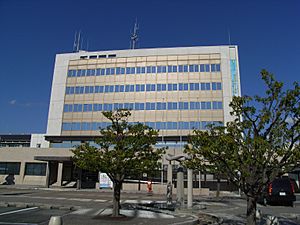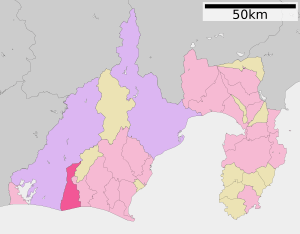Iwata, Shizuoka facts for kids
Quick facts for kids
Iwata
磐田市
|
|||||||||||||
|---|---|---|---|---|---|---|---|---|---|---|---|---|---|

Iwata City Hall
|
|||||||||||||
|
|||||||||||||

Location of Iwata in Shizuoka Prefecture
|
|||||||||||||
| Country | Japan | ||||||||||||
| Region | Chūbu (Tōkai) | ||||||||||||
| Prefecture | Shizuoka | ||||||||||||
| Area | |||||||||||||
| • Total | 163.45 km2 (63.11 sq mi) | ||||||||||||
| Population
(October 2020)
|
|||||||||||||
| • Total | 166,672 | ||||||||||||
| • Density | 1,019.71/km2 (2,641.04/sq mi) | ||||||||||||
| Time zone | UTC+9 (Japan Standard Time) | ||||||||||||
| Phone number | 0538-37-4827 | ||||||||||||
| Address | 3-1, Kōnodai, Iwata-shi, Shizuoka-ken 438-8650 | ||||||||||||
| Climate | Cfa | ||||||||||||
|
|||||||||||||
Iwata (磐田市, Iwata-shi) is a city located in Shizuoka Prefecture, Japan. As of 2019, about 170,000 people lived there. The city covers an area of 163.45 square kilometers (63.11 sq mi).
Iwata is famous as the home of the Yamaha Motor Corporation. This company makes motorcycles and other vehicles. The city is also home to two popular sports teams:
- Júbilo Iwata, a professional soccer team in the J. League.
- Yamaha Jubilo, a professional rugby team.
Contents
Geography of Iwata
Iwata is in the southwestern part of Shizuoka Prefecture. The Tenryū River forms its western border. To the south, the city has a small coastline along the Pacific Ocean.
Neighboring Cities and Towns
Iwata shares its borders with several other places in Shizuoka Prefecture:
- Fukuroi
- Hamamatsu
- Mori
Population Growth in Iwata
The number of people living in Iwata has grown steadily over the last 60 years. This shows that more and more people are choosing to live in the city.
| Historical population | ||
|---|---|---|
| Year | Pop. | ±% |
| 1960 | 105,489 | — |
| 1970 | 111,452 | +5.7% |
| 1980 | 145,751 | +30.8% |
| 1990 | 157,219 | +7.9% |
| 2000 | 166,002 | +5.6% |
| 2010 | 168,616 | +1.6% |
| 2020 | 166,672 | −1.2% |
Climate in Iwata
Iwata has a climate with hot and humid summers. The winters are usually mild. The average temperature each year is about 16.3 degrees Celsius (61.3°F). July is the wettest month, with a lot of rain. August is the hottest month, and January is the coldest.
History of Iwata
Iwata is a very old place where people have lived for a long time. Tools made of obsidian and ancient shell piles have been found here. These show that people lived in Iwata even during the Japanese Paleolithic period.
Many old burial mounds, called kofun, are also found in the area. These mounds suggest that the region was important during the time of the ancient Japanese emperors. During the Nara period, Iwata was the capital and main temple location for Tōtōmi Province.
Later, during the Edo period, Iwata became a busy post station called Mitsuke-juku. This station was on the Tokaido highway, which connected the cities of Edo (now Tokyo) and Kyoto.
Modern Iwata
On October 1, 1889, Mitsuke Town was officially created. Later, in 1940, Mitsuke Town merged with other nearby villages to form the new town of Iwata. Iwata officially became a city on April 1, 1948.
In 2005, several other towns and a village merged with Iwata. These included Fukude, Ryūyō, Toyoda, and Toyooka. This merger made Iwata even larger.
Economy of Iwata
The economy of Iwata is mainly based on farming. The city is well-known for its green tea and special melons. These melons are grown in greenhouses and are called "Iwata melon."
Besides agriculture, Iwata is a major center for manufacturing. The Yamaha Corporation was started here. Its motorcycle division, Yamaha Motor, has its main office in Iwata. Suzuki Motor Corporation also has a factory in Iwata where they build vehicles.
Education in Iwata
Iwata has many schools for students of all ages.
- Shizuoka Sangyo University, a private university, is located in Iwata.
- Shizuoka Professional University Junior College of Agriculture is a public college that opened in 2020.
The city government runs 23 public elementary schools and 11 public middle schools. The Shizuoka Prefectural Board of Education operates four public high schools. There are also two special education schools for students with disabilities.
Iwata also has two international schools for children from other countries, especially Brazil. These are CEP Brasil and Escola Objetivo de Iwata Tia Rosa.
Transportation in Iwata
Getting around Iwata is easy with its railway and highway systems.
Railway Lines
 Central Japan Railway Company - Tōkaidō Main Line
Central Japan Railway Company - Tōkaidō Main Line
- Iwata – Toyodachō
- Tenryū Hamanako Railroad Tenryū Hamanako Line
- Shikiji – Toyooka – Kaminobe
Highways
 Tōmei Expressway
Tōmei Expressway National Route 150
National Route 150
Sister Cities
Iwata has special relationships with two cities in other countries:
 Dagupan, Philippines, since 1975
Dagupan, Philippines, since 1975 Mountain View, California, United States, since 1976
Mountain View, California, United States, since 1976
Local Attractions
Iwata has several interesting places to visit, including historical sites and natural wonders.
National Historic Sites
- Chōshizuka Kofun: An ancient burial mound.
- Former Mitsuke School: An old school building with historical importance.
- Mikuriyama Kofun group: A group of ancient burial mounds.
- Shinpōinyama Kofun group: Another group of ancient burial mounds.
- Tōtōmi Kokubun-ji: The site of an ancient provincial temple.
The Great Camphor Tree
Near Iwata Station, you can find the amazing Great Camphor tree of Zendo-ji. People believe this tree is about 700 years old! It used to be part of a Buddhist temple. The tree is very tall, about 18.3 meters (60 feet) high. Its roots spread out of the ground, making a huge base that is almost 33 meters (108 feet) around.
Notable People from Iwata
Many talented people have come from Iwata, including:
- Saori Atsumi – A singer-songwriter.
- Shuji Ishikawa – A professional wrestler.
- Mima Ito – A professional table-tennis player.
- Noriko Mizoguchi – A judoka (judo athlete).
- Jun Mizutani – A professional table-tennis player.
- Masami Nagasawa – A famous actress.
- Ryosuke Sasagaki – A professional soccer player.
See also
In Spanish: Iwata (Shizuoka) para niños






